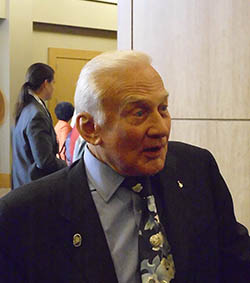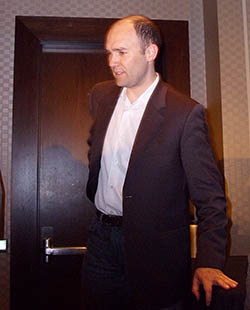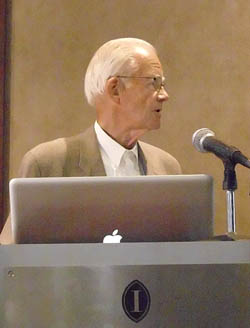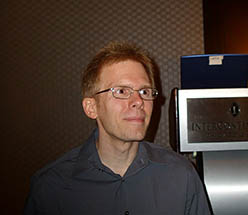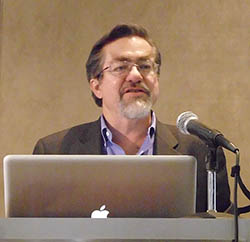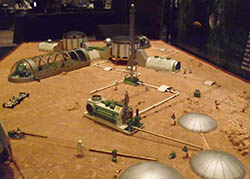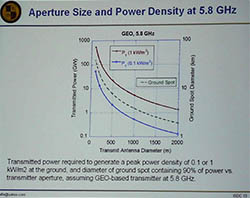International Space Development Conference Day 1
|
Buzz Aldrin at the Boeing Coffee
Eric Anderson, Space Adventures
Gordon Woodcock, Boeing (retired)
John Carmack, Armadillo Aerospace
John Mankins, SPS guru
A model Mars base in the exhibit hall
A typical slide at an ISDC presentation |
I arrived at 8:00am for the first day of the International Space Development Conference (ISDC). I took a walk around the hotel to get the lay of the land. Next stop was operations to see how things were going. The nice thing about being the web master for the conference is that once the conference is underway my job is pretty much done. Heading over to the Artist's Gallery (an open common area between meeting rooms) I saw my friend Veronica Zabala-Aliberto, Coordinator for the Lunar Reconnaissance Orbiter Camera at Arizona State University, who greeted me with a warm hug. The last time I had seen Veronica was when she had given me a tour of the LRO offices at ASU a couple years ago. Next it was off to the Space Solar Power Symposium. The SPS Symposium is chaired by John Mankins who opened the symposium with a summary of who is doing SPS research. The "who" consisted of both individuals and organizations. Following this was a presentation by Gordon Woodcock who provided an overview of past SPS research efforts. Much of this discussion focused on the Boeing study of the late '70s in which he was personally involved. At the break I headed over to registration but took a pass on standing in the long line. Registration was late in opening apparently due in large part to difficulties the hotel was having with their internet access. On the way back to the SPS program I ran into Wayne White who is currently employed by the Constellation program – meaning his future is uncertain given Obama's decision to kill the program. Once again I started for the SPS program but ran into Sherry Bell, the Dean of Psychology at Kepler Space University, from whom I received my second warm hug of the day. Back in the SPS room, Susumu Sasaki was giving a presentation about the Japanese Space Agency JAXA's work on SPS. He was followed by Paul Jaffe of the Naval Research Laboratory who spoke about a small (under $2 million) project at NRL working with technology that would be relevant to SPS. Next a coffee break sponsored by Boeing (thanks Boeing for the refreshments and desserts) where I spent some time speaking with John Olson, a director of the Space Frontier Foundation and later fellow NSS director Mark Hopkins. I next attended a joint presentation by Eric Anderson of Space Adventures and John Carmack of Armadillo Aerospace on their joint space tourism project. Space Adventures has contracted with Armadillo to provide the reusable space vehicles for launching space tourists on suborbital flights. John stated that he expects that within a year they will be flying unmanned science payloads to 100,000 feet and that within another year they'll be flying to 100km. He stated that they expect to operate at a loss for the next couple of years. The interesting thing about their model is that there will be no pilot for these flights. The only people aboard will be the tourists. Some people may find the idea of a ship with no onboard human pilot disconcerting In the q/a session that followed, Apollo 11 astronaut Buzz Aldrin quipped "Yuri Gagarin landed in a parachute." So concluded the first morning of programming at the ISDC. |
For the afternoon I attended the AIAA Space Colonization program track. First up was a presentation that was not at all about space colonization but rather a presentation that linked the major space programs of the U.S to how other countries perceived the will power of the U.S. Delivered by John Brandenburg, The Geopolitics of Space presented an interesting line of reasoning: Perception creates reality and deterrence is based on perception. When the U.S. is perceived as being strong in space, the U.S. is perceived as being a strong country, and vice versa. This presentation was followed by Gordon Woodcock and Strategy for Space Development in which Gordon pointed out to the audience that destinations are not goals and that our two goals should be 1) the successful economic development of space and 2) the extension of human civilization to space. The next talk was by track chair Anita Gale of Boeing whose talk Triggers for Space Settlement explained the scenarios created for students to address in the annual International Space Settlement Design Competition.
Then it was back to the SPS Symposium for a presentation by John Mankins on the results of the International Academy of Astronautics SSP study
That ended the programming for me. My next stop was the NSS Fundraising Committee meeting – already under way. After that it was dinner with fellow NSS director Robbie Gaines. Then back to the hotel for more conversation with various folks and then the drive home.
| Return to the Blog Index | This entry was posted on Thursday, May 27th, 2010 at 11:12 pm and is filed under National Space Society, Space Exploration.
